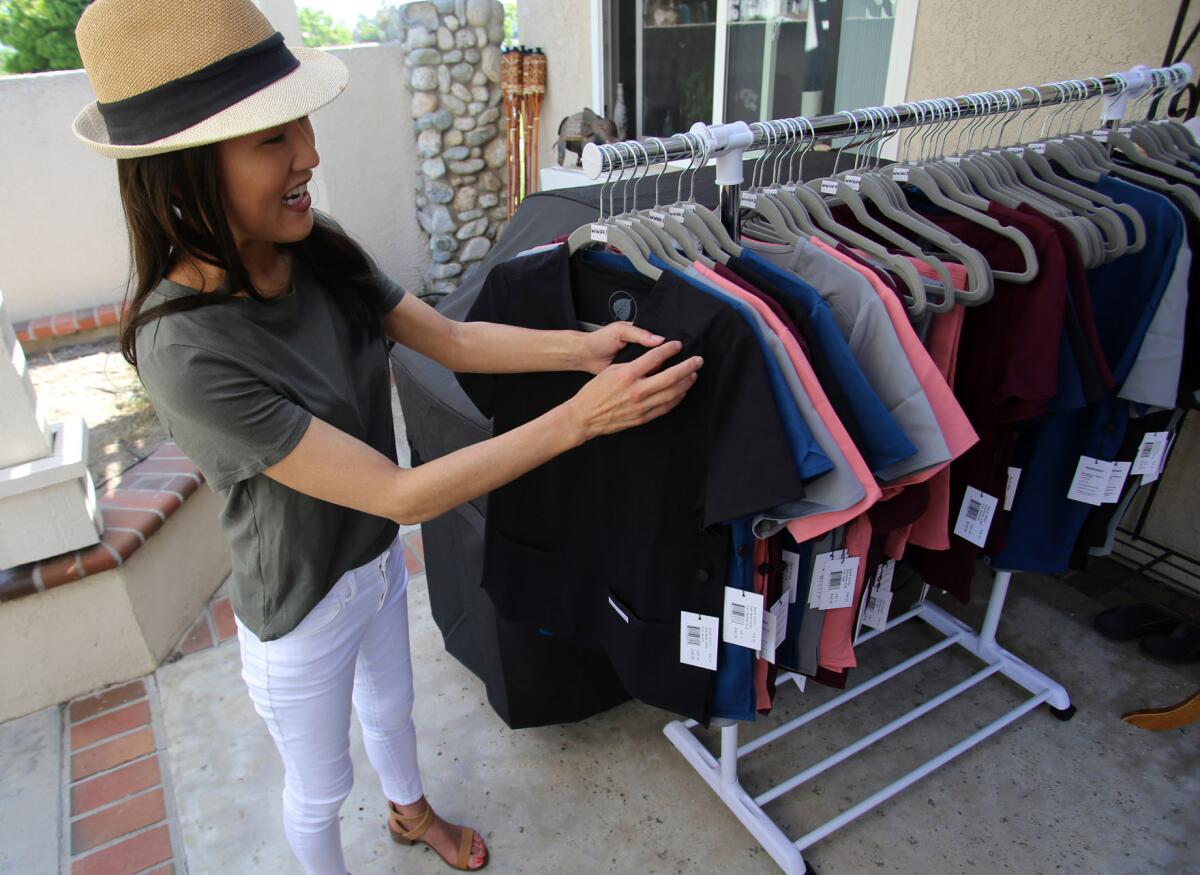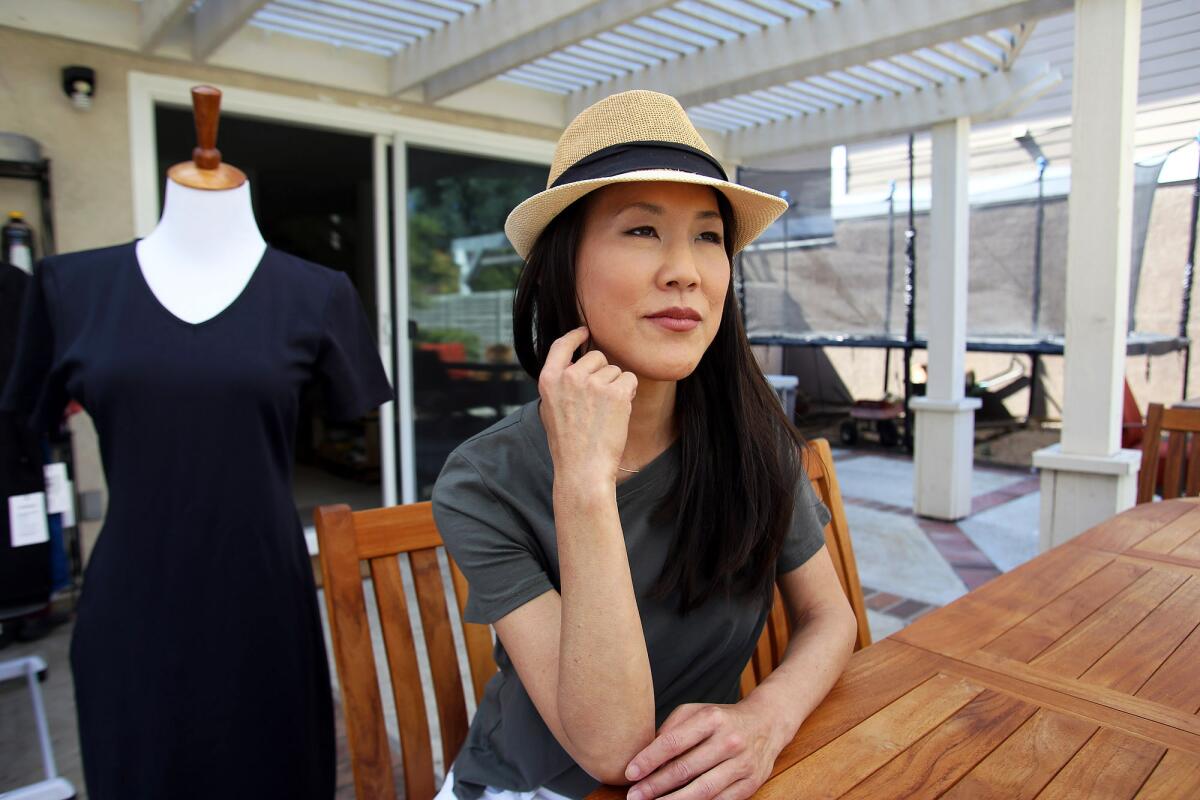Leukemia survivor designs scrubs to give back to medical community, raise awareness for bone marrow registry

- Share via
Before Jenny Beeghly was diagnosed with leukemia in 2018, she was the type of person who would organize 30-day fitness challenges at work.
The Irvine-based, Korean American mother of two kept a balanced lifestyle. Yes, she’d lead her co-workers in squats, sit-ups and stair climbs, but she’d also search out delicious foods — the best pizza, pork belly, Vietnamese spring rolls or ricotta jam toast.
“One thing I was always grateful for was my health,” she says. “So [the diagnosis] came to me as a big surprise.”
She started having night sweats and thought she might have an infection or peri-menopause. When she got a call to go to the emergency room, she was on her way to a work event. She’s been in the fashion industry for over 20 years, working for brands like BCBG Max Azria, Wet Seal and Quicksilver.
She remembers telling her friends: “I have to go to the E.R. first, but I’ll see you guys there later.”
A healthy white blood cell count is about 4,000 to 11,000. Hers was 180,000. She learned she had acute lymphoblastic leukemia.

“We were just getting to the good part of life,” she says of her and her husband, who have two daughters, 8 and 14. “We got through the infant [and middle childhood] stage, I was building up my career, and I was just thinking, ‘Now we get to enjoy ourselves a little bit more.’ ”
She didn’t know anything about leukemia, but she soon found out that she needed a bone marrow transplant.
Only 30% of patients find a match within their families, and it’s more likely to find a match within one’s same racial and ethnic community.
“When I found out there aren’t that many Asians [registered], and on top of that, not many Koreans, you feel helpless,” she says, quietly.
A white patient has a 77% chance of finding a life-saving match. The numbers decrease dramatically for people of color. Native Americans have a 57% chance; Latinos, 46%; Asians or Pacific Islanders, 41%; and African Americans, 23%.
At first, there were no matches for Beeghly. But then she learned about Asians for Miracle Marrow Matches, a nonprofit organization affiliated with the Be The Match national marrow program that focuses on recruiting more donors from the Asian American community.
“All my friends and family inundated them, trying to organize booths,” Beeghly says. “They set up a booth at the Korean festival in Irvine. And they weren’t waiting for people to come to the table. They approached people ... How can you say no when my husband tells you he needs a donor for his wife?”
They got 114 signups in one day, compared with 11 the year before. Beeghly’s supporters organized booths in churches, universities, even at the San Francisco Giants’ Korean night game.
“A long time ago, somebody had asked me to [join the registry], and I said no,” Beeghly says, embarrassed. “Because I was not educated. I was scared. I thought it would be painful. And now that I know, I have to let people know that it’s not painful and you can really help someone.”
A simple cheek swab is all it takes to join the registry. Only 1 in 300 people are ever selected as the best possible donor. And if you match, donating bone marrow is low-risk, requires about a week for full recovery and rarely has long-term side effects.
Beeghly found a match. But earlier this year, eight months into recovery, she relapsed. Beating the odds, she found another match.
While she was in the hospital, her cousin James Lim called daily.
“I’m an only child,” she says, “so he’s like a brother to me.”
One day, Lim suggested that they start a scrubs company.
A physician that works in the emergency room, he’d always wished for improved scrubs, but he and Beeghly had never thought about working together until her cancer diagnosis.
“Scrubs are traditionally not meant to be designer,” Lim says. “But now that this whole athleisure movement has gained traction — with Lululemon bringing more stylish clothes into the gym and Hugo Boss making a washable suit that you can do cartwheels in — we want to bring athleisure to healthcare.”
“It was a way for me to combine passion and purpose,” says Beeghly, who wanted to give back to the medical professionals who had helped her along the way.
“Being a healthcare worker is not a glamorous job like how ‘Grey’s Anatomy’ portrays it most of the time,” says Lim. “It is brutally stressful at times. It’s very long hours, so the small things like getting a cup of coffee or taking a break or wearing comfortable scrubs ... those little things can make your day.”
It would also be a way for Beeghly to help Be the Match and A3M spread the word about the need for more bone marrow donors from minority communities, including mixed-race patients.
They named their scrubs line Perilla, after the perilla leaf, an herb often used in Korean cuisine, which has purported health benefits.

Perilla comes in knit and woven fabrics. They’re stretchy, antimicrobial, wrinkle-resistant and anti-fade. The designs are doctor-approved, constructed based on feedback from Lim and his hospital co-workers, and each piece on the website is named after a family member.
Beeghly often thinks: Why did this happen to me? Why did I get leukemia? And how was I lucky enough to find a match twice, when so many people have to wait years?
So even if her friends and family are concerned when they see her working so soon, she explains that Perilla has given her a renewed sense of purpose.
“I’m actually terribly shy,” she says of going public with her story. “But I have to focus and get over all of my insecurities, because it’s for the greater good. We need more people to become donors. We have to find these matches.”
All the latest on Orange County from Orange County.
Get our free TimesOC newsletter.
You may occasionally receive promotional content from the Daily Pilot.






